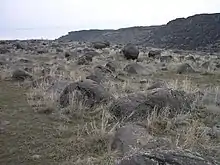Melon gravel are a geological deposit of mostly basalt boulders that were formed by the Lake Bonneville flood and deposited along the Snake River Plain in the United States around 15,000 years ago.[1] Melon gravel range in size from coarse sand to well over 15 feet in diameter, and generally appear rounded.[2] Melon gravel were formed by the Bonneville Flood's intense erosion of the surrounding basalt flows of the area. This process also created several bars of melon gravel that, at their largest, can be 1-mile (1.6 km) long, 1.5-miles (2.41 km) wide, and 150 feet (45.72m) deep.[3]
Melon gravel are considered to be "the most easily recognized evidence of the catastrophic magnitude of the [Bonneville] flood".[4] Melon gravel was named after road signs were put up advertising "petrified watermelons", with one sign urging people to "Take one home to your mother-in-law!"[5]
Petroglyphs
The petroglyph locations of the Snake River Valley are selectively located on melon gravel. Researchers have pondered why Native American artisans used melon gravel instead of the Snake River Canyon's walls. One theory is that melon gravel were considered a sacred object to the local Native Americans.[6]
In the western United States, power and life were considered to be closely linked with water in Native American spiritual beliefs.[7][8] Many creation myths follow similar storylines of a water-covered Earth, and animals, like coyotes, turtles, weasels, or other water creatures, creating land and populating it.[9] These beliefs have been recorded among the local indigenous groups in California, the Great Basin, and the Columbia Plateau.[10][11][12]
The sacred power of water is also referenced in a Western Shoshone myth of purification:
Once upon a time there was a man. He got mad and said, 'Our land doesn't seem to smell good. Everything stinks. I think we better make another land.' They slept that night and all through in the night he sang and sang and sang. He wished for a great water. The great water came. It took everything away and cleaned up all the land. It washed the highest mountains everywhere. The people went to the top of the highest mountain and stayed there until the water went down. It went as this man wished it would. After the water died down, the land and everything was perfect and clean again.[13]
Rock itself was also considered a powerful spiritual force.[6] Shamans were, and still are, widely believed to have the ability to enter the sacred. One of the ways to enter the sacred was using rock art.[14][15] In general, rock art is considered in many Native American beliefs to play a key role in myths, historical events, initiation events, and visions.[16]
These ideas are applicable to the melon gravel formed by the Bonneville Flood, since Native populations were able to recognize that melon gravel were formed fluvially and thus attribute a sacred meaning to them, hence why they would choose melon gravel as petroglyph sites.[6]
References
- ↑ "The Lake Bonneville Flood". Digital Atlas. The Digital Atlas of Idaho. Retrieved 8 July 2022.
- ↑ Malde, Harold; Powers, Howard (1962). "Upper Cenozoic Stratigraphy of Western Snake River Plain, Idaho". Geological Society of America Bulletin. 73 (10): 1197–1220. doi:10.1130/0016-7606(1962)73[1197:UCSOWS]2.0.CO;2. Retrieved 8 July 2022.
- ↑ "Geologic Unit: Melon". Geolex. USGS. Retrieved 8 July 2022.
- ↑ Malde, Harold (1968). "The Catastrophic Late Pleistocene Bonneville Flood in the Snake River Plain, Idaho" (PDF). Geological Survey Professional Paper 596: 13. Retrieved 8 July 2022.
- ↑ Meldahl, Keith (16 October 2011). Rough-Hewn Land: A Geologic Journey from California to the Rocky Mountains. University of California Press. p. 132. ISBN 978-0520275775. Retrieved 8 July 2022.
- 1 2 3 Pavesic, Max (2007). "The Bonneville Flood Debris Field as Sacred Landscape" (PDF). Journal of California and Great Basin Anthropology: 22–23. Retrieved 8 July 2022.
- ↑ Miller, Jay (1983). "Great Basin Region and Theology: A Comparative Study of Power". Journal of California and Great Basin Anthropology. 5 (1 and 2): 78. Retrieved 8 July 2022.
- ↑ Paper, Jordan (1990). "Through the Earth Darkly: The Female Spirit in Native American Religion". Religion in Native North America: 3–19. Retrieved 8 July 2022.
- ↑ Hultkrantz, Ake (1986). "Mythology and Religious Concepts". Handbook of North American Indians. 11: 630–640. Retrieved 8 July 2022.
- ↑ Clark, Ella (1953). "Indian Legends of the Pacific Northwest". Berkeley: University of California Press.
- ↑ Clark, Ella (1966). "Indian Legends of the Pacific Northwest". Norman: University of Oklahoma Press.
- ↑ Heizer, Robert (17 June 1978). "Title Unknown". Handbook of North American Indians. 8. OL 23238489M. Retrieved 8 July 2022.
- ↑ Smith, Anne (23 April 1993). Shoshone Tales. University of Utah Press. p. 108. ISBN 0874805708.
- ↑ Whitley, David (1994). "Shamanism, Natural Modeling and the Rock Art of Far Western North America". Shamanism and Rock Art in North America. Retrieved 8 July 2022.
- ↑ Lewis-Williams, David; Dowson, Thomas (1988). "The Sign of All Times: Entopic Phenomena and Upper Paleolithic Art". Current Anthropology. 29 (2): 201–245. doi:10.1086/203629. S2CID 147235550. Retrieved 8 July 2022.
- ↑ Grant, Campbell (1968). Rock Drawings of the Coso Range, Inyo County, California: An Ancient Sheep-hunting Cult Pictured in Desert Rock Carvings. Maturango Museum. ISBN 9780943041001.
